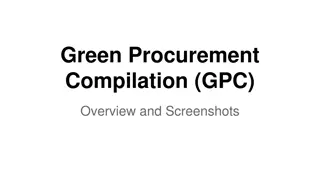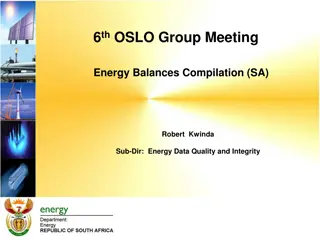Tackling Issues in Regional Economic Compilation
Addressing challenges in compiling regional accounts, focusing on defining regional economy, handling multi-regional enterprises, estimating regional GDP, and other related topics.
Download Presentation

Please find below an Image/Link to download the presentation.
The content on the website is provided AS IS for your information and personal use only. It may not be sold, licensed, or shared on other websites without obtaining consent from the author.If you encounter any issues during the download, it is possible that the publisher has removed the file from their server.
You are allowed to download the files provided on this website for personal or commercial use, subject to the condition that they are used lawfully. All files are the property of their respective owners.
The content on the website is provided AS IS for your information and personal use only. It may not be sold, licensed, or shared on other websites without obtaining consent from the author.
E N D
Presentation Transcript
Viet Vu Consultant to United Nations Statistics Division 15-17 March 2010
Problems to be tackled in the compilation of regional accounts Issue 1: Toward a definition of a regional economy according to SNA 2008 Definition of regional economy (a state, province, or district) and its residents when no international definition has been proposed Recommendations Issue 2: Regionalize multi-regional enterprises at data collection stage: Method for imputation in data collection, Treatment of multi-regional enterprises and treatment of national industry. Issue 3: Regional GDP compilation Regional GDP by estimation/extrapolation Evaluation of data requirement by three approaches: production, income and final expenditure. Recommendations.
Problems (continued) Issue 4: Annual and quarterly GRP. Issue 5: Toward demand approach. Issue 6: Toward regional household income. Issue 7: Issue of informal activities (other session). Issue 8: GRP in constant prices and deflation (other session). Issue 9: Issue of institutional arrangement: centralization versus decentralization (other session).
ISSUE 1 Toward a definition of a regional economy on the basis of the SNA2008
SNA2008 and regional accounts SNA2008 has not explicitly discussed nor set standards for regional accounts. However, SNA2008, unlike SNA1993, has redefined the statistical unit in such a way that any local unit in a region even without any sale, will be recognized as a production unit (or an establishment) as long as it incurs costs of production (expenses on goods and services, wages and salaries and owns fixed assets). The rest of a regional accounts can follow national accounts as long as one can clearly define and delineate a region, and its resident units in terms of institutional units, production units, consumer units within it.
Residents of the national economy or a regional economy Whether a unit is a resident of a location (national or regional economy) depends on whether it has the predominant economic interest in it or not. A predominant economic interest has the following key features (SNA2008, para.4.10-4.14): Effective economic control of a single government in terms of rights to ownership (land area, airspace, territorial waters) and to exploitation (fishing, fuels, minerals). Government authority is reflected in registration, license, lease requirement, tax payment, royalty payment. Existence of a location, dwelling, place of production where production activity takes place for a finite but significantly long period of time (1 year or over)
Concept of regional economy on the basis of SNA2008 concept of the national economy National economy Residents of the national economy: must have a centre of predominant economic interest in the national economy. Extra-territorial organizations: Residents outside of national territory have the national economy as the predominant centre of economic interest. Multi-national enterprises: Even not having a branch but have operating location or payment of taxes to the country, a segment of it will be allocated to the country. Regional economy Residents of a regional economy: must have a centre of predominant economic interest in the economic territory of the region. Residents of supra-regional territory: Residents have only the national economy as the centre of predominant economic interest; not tied to any particular region (or regional govnt). Multi-establishment enterprises with registered local units: Local units in the region will be recognized as establishments. National industries that have some operating activities at the regions (railroad, highway): a region is allocated only with the part that operate in it.
Compare extra-territorial organizations and supra-regional units (1) Supra-regional territory/ supra- regional units Extra-territory/extra-territorial organizations National air-space, territorial waters and the continental shelf lying in international waters over which the country enjoys exclusive rights; Territorial enclaves {i.e. geographic territories situated in the rest of the world and used, under international treaties or agreements between States, by general government agencies of the country (embassies, consulates, military bases, scientific bases etc.)}; Deposits of oil, natural gas etc. in international waters, outside the continental shelf of the country, worked by resident units. Similar categories (particularly 1 and 2) can be defined for supra-regional territory which include those that do not attach to any particular region. 1. National air-space, territorial waters and the continental shelf lying in supra-regional territory over which only the national government enjoys exclusive rights and authority; 2. Deposits of oil, natural gas etc. in over which the national government has exclusive rights and authorities, which may be worked by resident units of any region. 1. 2. 3.
Compare extra-territorial organizations and supra-regional units (2) Supra-regional territory/ supra- regional units Extra-territory/extra-territorial organizations Can employ residents of other regions of the country. Pay compensation of employees to residents of other regions of the country. Buy goods and services from other regions of the country. Can employ residents of the country (such as foreign embassies employ citizens of the country) Pay compensation of employees to nationals (treated as compensations of employees received from the rest of the world). Buy goods and services in the country (exports of that country)
Implications of SNA rules on regional economies A regional economic territory is generally tied to a geographical territory but the two are not identical. When a unit has predominant centre of interest in the national economy only, it should be treated as a resident of a supra-region of the nation. This recommendation is consistent with the SNA to set up a supra-regional territory and supra-regional residents within a national economy. This is equivalent to extra- territory organizations adopted by the SNA. It is also consistent with the SNA to have national enterprises (or production units) operating across many regions, similarly to multi-national enterprises.
Recommendations on supra-regional units case of Malaysia Oil and gas production off-shore or even on shore should be treated as supra-regional units if ownership reflected in the ability to negotiate contract of operation, receive royalties, imposing taxes is with the central government or a central government-owned enterprises. Regional government may receive part of the royalty. This should be treated as current transfer from the central government to the state government. Advantages of this treatment: GDP per capita will be lower, reflecting actual income that residents of the state has control over. Rate of growth will not be dominated by the growth of oil and gas production when those activities make up a large share of GDP if included in GDP.
ISSUE 2 Regionalize multi-regional enterprises at the data collection stage
Regionalize production activity of multi- regional enterprises by SNA2008 SNA1993 SNA2008 Only local units which have market output are treated as establishments. Local units that produce ancillary activities such as headquarter services, warehousing, transport, etc. are not establishments, producing no output. Ancillary units are aggregated to principal establishments. Regional accounts are not possible Local ancillary units can be treated as establishments. Output of ancillary establishments is measured by cost. Output = intermediate consumption + compensation of employees + consumption of capital + other taxes on production. Regional accounts are possible
Steps to regionalize a multi-regional enterprise Step 1: Collect cost of production on ancillary local units, and output (or information to compile output) of establishments in the enterprise. Output of ancillary local units, such as headquarter, warehousing, repair centers, etc. are calculated by production costs. Step 2: Allocate the output of ancillary local units as intermediate consumption to establishments. Note: allocation can be done only if the link between production establishments and ancillary establishments in a given enterprise are well established in a database.
Cost allocation of multi-regional enterprises with many local units Old treatment (1993 SNA) New treatment (2008 SNA) Example Headquarter Establishment 1 (principal) Establishment 1 (principal) Establishment 1 (principal) Establishment 2 (secondary) Establishment 2 (secondary) Establishment 2 (secondary)
Example of the allocation technique DATA GIVEN Establishment 1 Establishment 2 Headquarter Output: 200 IC: 100 VA = 100 Output: 100 IC: 30 VA = 70 No revenue/sale IC: 30 VA = 15 SNA1993 GDP = 140 Establishment 1 Establishment 2 Output: 200 IC: 100 + 30 VA = 70 Output: 100 IC: 30 VA = 70 SNA2008 GDP = 140 Establishment 1 Establishment 2 Establishment 3 Output: 200 IC: 100+30 VA = 70 Output: 100 IC: 30+15 VA = 55 Imputed output:45 IC: VA: 15 30
Some caveats Some of the transactions of multiregional units cannot, strictly speaking, be regionalizable. This is the case for most distributive and financial transactions. Consequently, balancing items of multiregional units may not be unambiguously defined at the regional level for multiregional units.
ISSUE 3 Regional GDP (RGDP) estimation/ extrapolation
Final demand approach? Final demand expenditures include: Final consumption of households and NPISH Final consumption of government Gross capital formation Exports Imports The most difficult issue is to obtain exports and imports of each region. This is possible only if censuses and regular surveys on commodity flows through transport surveys between states are implemented. Some countries may use location quotients to estimate net imports depending Location quotients are for economic analysis, compilation should be based on actual statistics, not simply on assumptions. It does not seem that any country has used the demand approach to obtain directly regional GDP (RGDP) at the state levels.
Production or income approach? Income approach requires the following information on enterprises: Compensation of employees (COE) Profits, depreciation, property and income transfers Income approach is possible when most of enterprises are incorporated so that the data above can be obtained from enterprise survey. The rest (household unincorporated enterprises) will be based on production approach Draw back: The income approach cannot be applied to get RGDP by industries as profits cannot be allocated to establishments. To apply income approach, given COE, operating surplus may have to be allocated on the basis of shares of COE. Advantage: The RGDP derived from income approach provides data to cross-check on the reliability of the value derived by the production approach.
RGDP by production approach Best approach: bottom-up approach wherever possible Obtain information directly by surveying agriculture, mining, construction, manufacturing and services and by using administrative data on government activities. Use indicators to allocate national aggregates by top-down approach only for national activities that cross many regions. Second best approach: apply when production data are not available or for extrapolation purpose Obtain appropriate indicators reflecting constant production growth in order to extrapolate GDP (or precisely value added) by each economic activity. Revise these preliminary extrapolated GDP by incorporating actual RGDP data when they are made available.
On what principle regionalization or extrapolation is based on? Production method: Extrapolation of regional GDP must be production indicators. Production indicators are not the same as demand indicators For national economy, production indicators may be the same as demand indicators if imports and exports are zero For regional economy, when demand is significantly supplied by other regions, demand indicators do not work. The best indicators by ranking: Quantity output Wages and salaries (must be deflated by wage rates) Employment (preferably working hours) Sale taxes on products (must be deflated by CPI)
On what principle (continued) Indicators that can used may vary from country to country due to: Data availability as time series Appropriateness of the data Steps to be taken in selecting indicators for allocation/extrapolation: Make a list of available data as time series that are relevant to a specific activity. (Avoid data that are available on ad-hoc basis). Test the data on past data to see if it can track well the actual development Select the best indicators GDP and GRP must be based on indicators that are consistent to one another otherwise GRPs would not add up to GDP.
ISSUE 4 Regional GDP (RGDP): annual and quarterly: Review of data Recommendations
Current status of statistics in the country (N, R) Census Annual survey/ administrative reports Quarterly, monthly surveys Possible replacement indicators Agriculture N,R N,R N,R Mining N,R N,R N,R Employment, COE, taxes Construction N,R N,R N,R Employment, COE, taxes Manufacturing N,R N,R N,R Employment, COE, taxes Wholesale/retail N,R N,R N,R Employment, COE, taxes Finance Central Bank Central Bank Central Bank Employment, COE, taxes Transport N,R N,R N,R Employment, COE, taxes Other services N,R N,R N,R Employment, COE, taxes
Current status of statistics on regional economies income approach Data for corporations: Wages and salaries, depreciation, profits, etc. Income approach can be applied to the corporations sector. Data for general government: Data and the approach is the same as the production approach Data for household unincorporated enterprises: Data and the approach is the same as the production approach
Current status of data and recommended approaches for regional GDP The best approach is production approach, given the facts that: Production data is more comprehensive The desire of policy makers is to have RGDP by industries. For the compilation of regular RGDP, a combination of employment from both Establishment Survey and Labor Force Survey will have to be used. Nonfarm employment in informal activities = Employment from Labor Force Survey less Employment from Establishment Survey. Nonfarm employment in informal activities are used to extrapolate value added in nonfarm informal activities. Conditions to be satisfied: state GDP by industry must add up to national GDP by industry.
Notes on data estimation (1): agriculture &crude oil and gas State estimates of GDP by industries should as follows: Agriculture: Agriculture output and value added are not proportional to employment (crops may depend on weather and size of cultivated land. Land yield technique should be applied to estimate output and value added. Oil and gas: Output of crude oil and gas may depend on government decision on the scale of pumping and prices rather than employment. Data from government agencies specialized on oil and gas or private marketing agencies should be the main sources. Pipeline: output or value added may be estimated by share of uses at the local level
Notes on data estimation (2): Manufacturing and services Employment or compensation of employees can be used to estimate output and value added.
Notes on data estimation (3): industries not covered by economic surveys and also without data on employment Indicators to be used for allocating national GDP to states Fisim: allocated by share of loans and deposits. Life insurance: allocated by shares of premiums paid. Nonlife insurance: allocated by shares of premiums paid. If data are not available, alternative indicators such as the number of cars registered (for car insurance), number of dwellings (for residential building insurance), etc. may be used Owner-occupied housing services: share of population with housing weighted by relative indicators of wealth (for which per capita income is a proxy).
Notes on data estimation (4): use of employment in Labor Force survey and adjust informal employment for lower productivity In case that employment in the industry is available from both Labor Force Survey (LFS) and Economic survey (ES) (covering only incorporated units in the list frame), the difference is considered employment in the informal sector. LFS is household based survey. ES is registered establishment based survey. Employment in the informal sector will be converted to ES labor equivalents by adjusting for their lower productivity. The adjustment ratio = (output/labor ratio in ES)/(output/labor ration in very small enterprises in ES). Adjusted employment equivalent = ES employment + ES labor equivalents in informal sector. This adjusted employment will be used to extrapolate regional constant value added. This is also adjusted for productivity growth of the industry. (Method of extrapolation will be discussed next).
Method of extrapolation to guarantee state GDP by industry to add up to national figure Problem: Using employment to estimate/extrapolate output assumes labor has the same productivity. Estimates are done separately for each region. This must be adjusted so that the sum of regional GDP is equal to the national GDP for each individual industry. Steps to be taken: 1. Obtain preliminary regional industry GDP by extrapolating regional industry GDP of the previous year with the rate of growth of regional employment equivalent in the industry or other indicators. 2. Calculate the national productivity index of the industry of the nation by dividing national industry GDP to the sum of preliminary industry GDP over all regions. 3. Assume that change in regional productivity index is the same as change in the national productivity index for every industry. 4. Adjust the preliminary state industry GDP in step 2 by multiplying it with the productivity index obtained in step 3. Note: the method only works if the regional GDP by industry totals to the national GDP by industry.
Example of extrapolation GDP in manufacturing - national Period 1 Period 2 Growth index GDP national 100 120 1.20 Employment in manufacturing/GDP preliminary estimates GDP in period 1 AdEmpl. Period 1 AdEmpl. Period 2 AdEmpl. growth index Preliminary GDP estimates State 1 70 120 130 1.08 75.8 State 2 30 80 90 1.13 33.7 National100 200 220 1.10 109.6 Productivity index for agriculture: 120/109.6=1.095 Adjusted estimate for period 2 Period 1 Period 2 (Adjust) State 1 70 75.8*1.095 83.0 State 2 30 33.7*1.095 37.0 National 100 120.0
ISSUE 5: toward demand approach(1) GRP = (HH+NPISH) final consumption + G final consumption + Gross capital formation + Net exports Demand approach may not be possible, but if a country wishes to have it, the following surveys/ administrative data are needed: Household expenditure survey and retail trade survey at the regional levels to estimate and extrapolate HH final consumption; Government final expenditure of central and regional government at regional levels; Capital expenditure survey at regional levels. Net exports will be derived as a residual given GRP is known from production approach. Even though the demand approach is unable to independently cross check the reliability of the supply approach, it will provide important data such as final consumption expenditure and gross capital formation at the state levels.
ISSUE 5: toward demand approach(2) Another approach to derive net exports is location theory, assuming that if a state produces less than the national average for a particular industry, it must import from other states. Location theory is based on location quotient calculated by using employment. Location quotient = (Employment in state i in industry j/Total employment in state )/(Employment in the nation in industry j)/Total employment in the nation). If location quotient of industry i is less than 1, the state must import output of i from other states. The location quotient is also called regional purchase coefficient. The import coefficient is (1- regional purchase coefficient).
Issue 6: Toward regional household income Regional household income is conceptually the same as national income. It is the income accrued to the households that can be used for final consumption or saving. The latter is used for investment in fixed assets or financial assets. Regional household income (or more precisely household income in the region) is equal to: Compensation of employees Operating surplus of unincorporated household enterprises Property income receivable less property income payable Current transfers receivable less current transfers payable (including taxes) For poverty assessment, entrepreneurial household income may be used instead of household income. Property income payable will not be deducted.




























